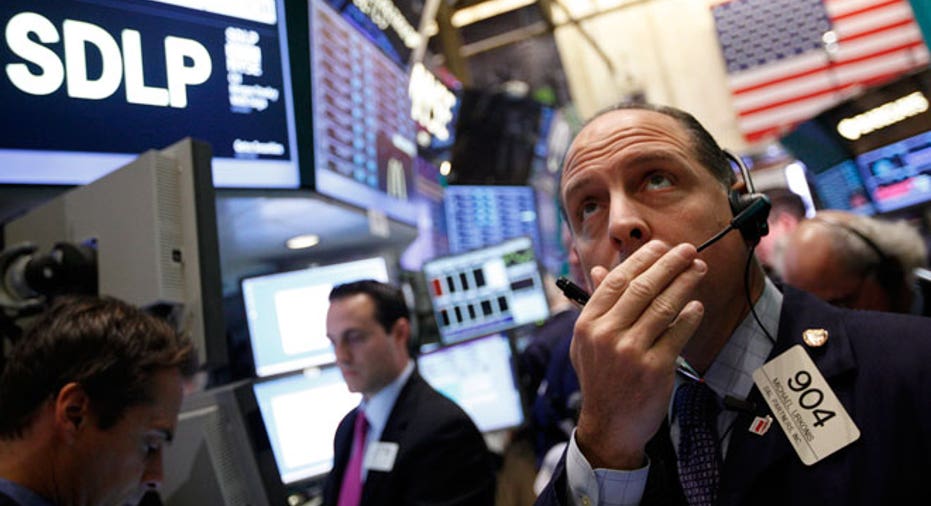Peering into a Fiscal Cliff Crystal Ball: Stocks Could Dive 15% by February

With the clock ticking on the fiscal-cliff negotiations, investors are increasingly dreading what their portfolios will look like if Washington fails to reach a deal before this $600 billion batch of spending cuts and tax increases wreaks havoc on the markets.
Investors appear to have good reason for their dread: a new risk analysis released by SunGard’s APT on Thursday shows the damage would be deep and far-reaching if the uncertainty created by the fiscal cliff lasts into early next year.
If a decision on the fiscal cliff is delayed by one month, the S&P 500 would likely tumble 15% from December levels and shares of banks like Citigroup (NYSE:C) and Goldman Sachs (NYSE:GS) could crumble by 25%, APT said.
The numbers are even scarier in the unlikely scenario that Washington fails to reach a deal within six months: U.S. equities would plummet 25% and American financials would plunge a hefty 35%.
To put that into perspective, a 25% selloff from Wednesday’s close would leave the S&P 500 at about 1068 and the Dow Jones Industrial Average back in four-digit territory at just 9934 -- the lowest level since June 2010.
“People easily forget how shocks can be so damaging. While we’re not putting a high probability on these scenarios, we’re pointing out that you cannot expect investors to hang around when they see shocks of this magnitude,” said Laurence Wormald, APT’s head of research. “These are not doomsday scenarios. They are, we believe, realistic.”
APT based its gloomy analysis on a slew of sources, including projections from the Congressional Budget Office -- which warned falling over the fiscal cliff would cause a recession -- and the investment banks of Bank of America (NYSE:BAC) and J.P. Morgan Chase (NYSE:JPM).
(A full list of APT's fiscal-cliff risk analysis is available below.)
Fiscal Clock is Ticking
Ben Bernanke, the chairman of the Federal Reserve, warned on Wednesday that falling over the fiscal cliff “could have a very negative effect on hiring, jobs, wages, economic activity and investment.”
“It’s exceptionally important and urgent that Congress come to a sensible agreement” on the fiscal cliff, Bernanke said.
Bruce McCain, who helps manage more than $20 billion as chief investment strategist at KeyCorp.’s (NYSE:KEY) Key Private Bank, said he believes the losses forecast by APT sound “like pretty reasonable numbers.”
A 25% tumble in equities, as is projected in the six-month delay scenario, often accompanies a recession anyway, McCain noted.
However, McCain believes such a long delay is unlikely. “There is overwhelming public sentiment that they need to get their acts together. Both sides of the debate get hurt the longer this goes,” he said.
Market Hedges Sought
Wormald said APT created its fiscal-cliff forecast at the urging of his company’s clients, which feature about 150 institutional clients, including some of the world’s largest pension funds, sovereign wealth funds and hedge funds.
“They are pretty worried,” said Wormald. However, “they can’t just start selling everything. That would be stupid. Instead, they are looking to see what would be the smart hedges.”
Potential hedges could include gauges of market volatility, such as the Chicago Board Options Exchange Market Volatility Index, or VIX.
According to APT, volatility on U.S. equities would soar 30% in the one-month delay scenario and spike 50% in the six-month stalemate.
APT forecasts heavy losses across a slew of other asset classes if the uncertainty over the fiscal cliff persists.
The U.S. dollar could sink 10% against the beaten-down euro if the budget decision is delayed by one month and 18% in a longer six-month delay.
Selling in equity markets would hardly be contained to U.S. equities.
APT projects a 10% selloff in European stocks and an 8% drop for Asia-Pacific equities if a deal isn’t reached by the end of January. Those losses swell to 15% in the gloomier scenario.
“People easily forget how shocks can be so damaging,” said Wormald. “While we’re not putting a high probability on these scenarios, we’re pointing out that you cannot expect investors to hang around when they see shocks of this magnitude.”
Markets to Slam Big Banks
It’s clear from the APT forecast that banking stocks would suffer the brunt of the damage in a fiscal-cliff disaster.
A 35% plunge from current levels for Wells Fargo (NYSE:WFC), for example, would leave the global bank at about $21.77 -- a level unseen since May 2009 just after the financial crisis receded.
Financial institutions, still licking their wounds from the last crisis, would be hurt by the chain reaction of selloffs in other asset classes, especially on the credit side.
APT projects North American credit-default swaps would surge 30% even if the cliff talks are stalled by just a month and by 50% in the gloomier forecast. European CDS would climb 25% and 40%, respectively.
“When the economy slows from maybe 2% to nothing in a year, that’s a very big shock,” said Wormald. “You can’t shock the world’s biggest economy that much without severe impact on banks.”
Wishful Thinking?
Due to the U.S.-centric nature of the crisis, the losses would be more modest in the energy markets, where APT sees crude oil sinking just 8% in a one-month delay and 18% in the six-month stalemate. Volatility in oil, though, is seen hitting 30% and 50%, respectively.
APT didn’t give a probability of either of these dark fiscal cliff scenarios playing out,
“I don’t have a mole in the White House,” said Wormald.
But with less than three weeks remaining until the year-end deadline, President Obama and Congressional leaders do not appear to be close to a breakthrough compromise.
“Anyone who minimizes the potential for risky markets is thinking wishfully. It’s better not to think wishfully when you are an investor,” said Wormald.
Source: APT



















